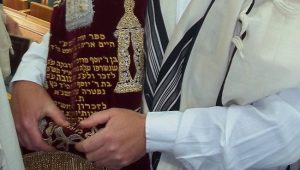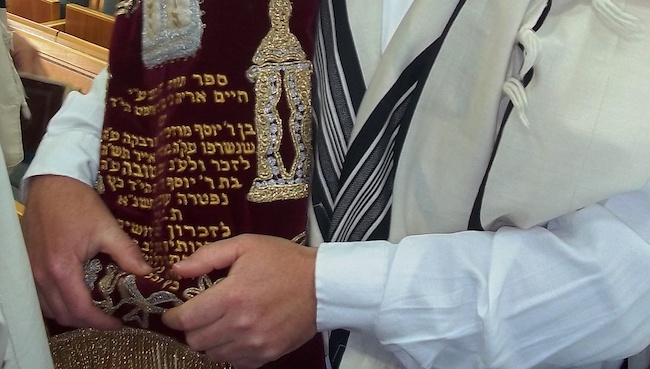
BS”D
Volume 34, No. 30
29 Iyar 5780
May 23, 2020
Sponsored by
David and Micheline Peller
on the yahrzeit of her father
Baruch ben Noach Hercberg a”h
The Katz family
on the yahrzeits of
Avigdor Moshe ben Avraham Abba Hakohen Katz a”h
and the other Kedoshim
of Oyber Visheve, Hungary, Hy”d
Sefer Vayikra, which we finished last week, ends with the verse: “These are the commandments Hashem commanded Moshe to [teach] Bnei Yisrael on Har Sinai.” Sefer Bemidbar, which we begin this week, opens with a census of the families of Bnei Yisrael. Midrash Yalkut Shimoni explains that these passages are related: The nations of the world complained that they were not given the Torah, and Hashem responded, “Bring Me your family trees!” What does this Midrash mean?
R’ Shmuel Shmelke Guntzler z”l (1834-1911; rabbi of Oyber-Visheve, Hungary for 45 years) explains: We say in the Pesach Haggadah, “If He had brought us to Har Sinai and not given us the Torah, it would have sufficed for us.” What would have been accomplished by bringing us to Har Sinai and not giving us the Torah? Commentaries explain: We do not mean, “If He had not commanded us to perform the Mitzvot.” Rather, “Given us the Torah” in this context refers to Hashem’s placing the Torah in our hands, meaning that Torah scholars can interpret the Torah, and their interpretations and Halachic rulings “become” G-d’s Torah. Indeed, even a prophet or a Bat Kol / Heavenly voice cannot overrule a Halachic ruling arrived at using the tools of Torah study.
How could Hashem give His beloved treasure, the Torah, to us to interpret? R’ Guntzler explains: Hashem did not give the Torah to the Patriarchs or to Yaakov’s sons; rather, say our Sages, He waited until Bnei Yisrael numbered 600,000. The Gemara (Berachot 58a) explains that, among 600,000 Jews, no two think exactly alike. Also, say our Sages, the Torah has 600,000 letters. In fact, the Torah has only 304,805 letters. But, what the Sages mean is that every Jew who was present at Har Sinai represents some aspect of the Torah. Collectively, the 600,000 who were present at Har Sinai had in their minds every possible legitimate Torah interpretation that would ever be offered; thus, our interpretations of the Torah – as long as they follow the rules set down by our Sages – were themselves given at Sinai. Notably, adds R’ Guntzler, the Gematria of “Sinai” also is 600,000. [For the calculation of this Gematria, see the explanation following this Dvar Torah.]
In this light, we can understand the Midrash Yalkut Shimoni with which we began. The census in our Parashah, which was taken not long after the Giving of the Torah, confirms that Bnei Yisrael numbered 600,000 people and that they were all genealogically from the same nation; meaning that they could represent the entirety of Torah. Said Hashem to the nations that demanded the Torah: Can you demonstrate the same? (Meishiv Nefesh)
********
As mentioned above, R’ Guntzler writes that the Gematria of “Sinai” equals 600,000. That Gematria is calculated as follows:
“Sinai” is spelled: Samech (=60), Yud (=10), Nun (=50), and Yud (=10). Multiplying those figures (60 x 10 x 50 x 10) produces 300,000.
Next, spelling out the names of those letters gives us the following:
- Samech = Samech, Mem, Chaf;
- Yud = Yud, Vav, Dalet;
- Nun = Nun, Nun;
- and (again) Yud = Yud, Vav, Dalet.
Adding the hidden letters of each name together (for example, the Mem and Chaf of “Samech”; the Vav and Dalet of “Yud”) again produces 60, 10, 50, and 10, which, multiplied together, produces another 300,000, for total of 600,000.
********
“For Dan, Achiezer ben / son of Ammishaddai.” (1:12)
R’ Chaim Yehuda Meir Hager z”l (the Vishever Rebbe in Tel Aviv; died 1968) writes: Hashem is our “Father,” but he recognizes us as His “sons” only when we care about our brethren, his other “sons.” The tribe of Dan traveled last, picking up all the objects that their brethren had lost and supporting any stragglers. Says our verse: For Dan, Achi-ezer / my brother is a helper, ben (from Binah) who reflects on my needs; therefore, Ami / my nation and Shakkai / G-d are united. (Zecher Chaim)
********
“Nadav and Avihu died before Hashem when they offered an alien fire before Hashem in the Wilderness of Sinai, and they had no children.” (3:4)
Our Sages give several explanations for Nadav and Avihu’s deaths, including that they offered an “alien fire” in the Ohel Moe’ed, as our verse says, and that they refused to marry. In fact, writes R’ Menachem Mendel Hager z”l (1886-1941; rabbi, Rosh Yeshiva and Chassidic Rebbe of Oyber Visheve, Hungary), these two reasons are one. He explains:
The Gemara (Yoma 21b) states: “Although a fire comes down from Heaven upon the Mizbei’ach / altar, it is a Mitzvah to bring a man-made fire as well.” How, asks R’ Yehuda Halevi z”l (Spain and Eretz Yisrael; approx. 1075-1141) in his work Kuzari, can a spiritual fire from Heaven become a physical fire that burns on the altar? He answers: It is a wonder, just as it is a wonder that the spiritual Neshamah / soul can be housed in a physical body. R’ Hager notes that that latter wonder is so great that we acknowledge it in the blessing “Asher Yatzar” — specifically, when we say the final words, “He acts wondrously.”
R’ Hager continues: Why did Nadav and Avihu refuse to marry? Because they believed that they were so holy that they could not engage in something as mundane as marriage; the spiritual and the physical just don’t mix, they thought. However, they contradicted themselves when they brought a man-made fire into the Ohel Mo’ed! What place did their fire have alongside Hashem’s fire, according to their philosophy? Therefore, their spiritual souls left their physical bodies. (Sh’eirit Menachem)
********
Pirkei Avot
“All that Ha’kadosh Baruch Hu created in His world, He created solely for His honor, as it is said (Yeshayah 43:7), ‘All that is called by My Name, indeed, it is for My honor that I have created it, formed it, and made it.’ And it says (Shmot 15:18), ‘Hashem shall reign for all eternity’.” (Chapter 6, last Mishnah)
R’ Chaim Dov Stark shlita (Mashgiach Ruchani of Yeshiva Aderes Ha’Torah in Yerushalayim) writes: This Mishnah teaches that one who acts in a way that lessens Hashem’s honor defeats the very purpose for which the world was created. In turn, R’ Stark writes, this sheds light on the respect we owe other human beings.
He explains: Our Sages teach that one who publicly shames another person has no share in the World-to-Come. Surely, observes R’ Yerucham Levovitz z”l (Mashgiach Ruchani of the Mir Yeshiva; died 1936), there are worse sins than shaming someone. One who commits murder, for example, incurs the death penalty, while one who shames another person does not. Nevertheless, because man is created in the Tzellem / image of Elokim (Bereishit 1:27), one who shames another person effectively demeans G-d Himself. Conversely, one who honors another person honors Hashem, thereby furthering the purpose for which the world was created.
R’ Stark continues: Acknowledging the Tzellem Elokim in man not only is the foundation of one’s obligations to his fellow, it also is the foundation of one’s obligations to himself. One’s ability to elevate himself depends on his recognizing his own inherent greatness. Indeed, R’ Stark writes, the familiar Yiddish expression, “Se past mir nisht” / “It is beneath me [to do such-and-such bad, inappropriate, or immature thing],” can influence one even more than studying works of Mussar.
R’ Stark adds: The Gemara (Sanhedrin 37a) states that a Bet Din / rabbinical court would warn the witnesses in a capital case not to testify falsely, saying: “Adam, the first man, was created alone, in order to teach us that one who destroys a single Jewish life is considered to have destroyed an entire world . . . Therefore, every person is obligated to say, ‘The entire world was created for me’.” [Until here from the Gemara] Some commentaries understand that the second sentence is not part of what the Bet Din says to the witnesses. Others, however, say that it is part of the Bet Din’s warning to the witnesses. They are saying, in effect: “You, the witnesses, must recognize your own worth! The entire world was created just for you! Therefore, it would be beneath you to testify falsely.” (Ha’keter Ve’ha’kavod p.5)


